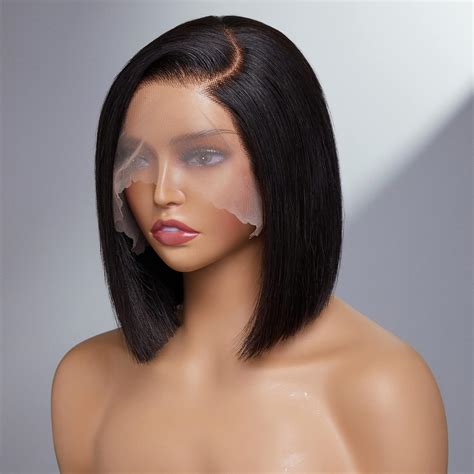The Booming Wig Industry: A Market Worth Billions
The global wig market is expected to reach a staggering $8.7 billion by 2025, driven by growing demand for fashion, beauty, and medical applications. With advancements in technology and design, wigs have evolved into an indispensable accessory that empowers individuals to express their unique style and address hair-related concerns.

Types of Wigs: A Wide Range to Suit Every Need
From premium human hair wigs to synthetic options, there’s a wig for every lifestyle and preference:
-
Human Hair Wigs: Made from real human hair, these wigs offer the most natural look and feel. They can be styled, colored, and heat-treated like your own hair.
-
Synthetic Wigs: Crafted from man-made fibers, these wigs are more affordable and easy to care for. They come in a vast array of colors, textures, and styles.
Benefits of Wearing Wigs: Beyond Fashion and Aesthetics
Wigs offer a multitude of benefits beyond their aesthetic appeal:
-
Hair Loss and Medical Conditions: Wigs provide a discreet and comfortable solution for individuals experiencing hair loss due to medical conditions or treatments.
-
Styling Versatility: Wigs allow you to change your hairstyle or color instantly, enabling you to explore different looks without damaging your natural hair.
-
Time-Saving Convenience: Wigs eliminate the need for daily hair care routines, saving you valuable time and effort.
Common Mistakes to Avoid When Choosing a Wig
To ensure a successful wig-wearing experience, avoid these common pitfalls:
-
Lack of Research: Do your homework and explore different wig types and brands before making a purchase. Consider your lifestyle, hair texture, and intended use.
-
Improper Fit: Ensure the wig fits securely and comfortably. Avoid wigs that are too tight or loose, as they can cause discomfort or slippage.
-
Unrealistic Expectations: Remember that wigs are not meant to replace your natural hair. They are an accessory that can enhance your look and provide a confidence boost.
How to Choose the Perfect Wig: A Step-by-Step Guide
-
Determine Your Hair Type and Color: Match the wig’s texture and color to your natural hair as closely as possible. This will ensure a seamless and natural look.
-
Consider Your Lifestyle: Choose a wig that suits your daily routine and activities. Human hair wigs may require more care, while synthetic wigs are more low-maintenance.
-
Read Reviews and Consult a Professional: Gather feedback from other wig wearers and seek advice from a hair stylist or wig specialist to make an informed decision.
Wig Care and Maintenance: A Vital Aspect of Wig Longevity
Extending the life of your wig requires proper care and maintenance:
-
Regular Washing: Use gentle shampoo and conditioner specifically formulated for wigs. Avoid over-washing, as this can damage the fibers.
-
Styling and Detangling: Use wide-tooth combs and heat-resistant tools at a low temperature to prevent tangling and damage.
-
Storage and Handling: Store wigs on a wig stand or in a breathable bag to maintain their shape and prevent matting.
Creative Wig Applications: Beyond Traditional Uses
The versatility of wigs extends beyond fashion and hair loss solutions. They offer unique opportunities for creative expression and problem-solving:
-
Cosplay and Character Costumes: Wigs transform ordinary individuals into extraordinary characters from movies, comics, and video games.
-
Medical Applications: Wigs can conceal hair loss caused by alopecia, chemotherapy, and other medical conditions, boosting patients’ confidence and well-being.
-
Special Effects and Theatrical Productions: Wigs play a crucial role in creating realistic and immersive experiences in theater, film, and television.
Table 1: Wig Types and Their Characteristics
| Wig Type | Material | Benefits | Drawbacks |
|---|---|---|---|
| Human Hair Wigs | Natural human hair | Most natural look and feel, versatile styling options | Expensive, require more care |
| Synthetic Wigs | Man-made fibers | Affordable, easy to care for, wide range of styles | Less natural look, may tangle more easily |
| Lace Front Wigs | Thin lace base with hand-tied hairs | Natural hairline, customizable styling | Delicate, more expensive |
| Full Lace Wigs | Constructed entirely of lace with hairs hand-tied throughout | Most realistic look, can be parted anywhere | Fragile, requires expert installation |
Table 2: Factors to Consider When Choosing a Wig
| Factor | Description |
|---|---|
| Hair Type | Match the wig’s texture to your natural hair for a seamless blend. |
| Hair Color | Choose a color that complements your skin tone and eye color. |
| Wig Cap Size | Ensure a secure and comfortable fit by measuring your head circumference. |
| Head Shape | Consider your head shape to find a wig that fits naturally and flatters your features. |
| Lifestyle | Choose a wig that suits your daily routine and activities. |
Table 3: Wig Care and Maintenance Tips
| Tip | Purpose |
|---|---|
| Use gentle shampoo and conditioner | Preserve the integrity of the wig fibers. |
| Wash regularly | Remove dirt and product buildup. |
| Use wide-toothed combs | Prevent tangling and damage. |
| Style with heat-resistant tools at low temperature | Avoid damage from excessive heat. |
| Store properly | Maintain the wig’s shape and prevent matting. |
Table 4: Creative Wig Applications
| Application | Benefits |
|---|---|
| Cosplay and Character Costumes | Transform into fictional characters for entertainment and self-expression. |
| Medical Applications | Conceal hair loss, boost confidence, and support well-being. |
| Special Effects and Theatrical Productions | Create immersive and realistic experiences for audiences. |
| Wig Design and Customization | Unleash your creativity by designing unique wigs for personal or professional use. |
